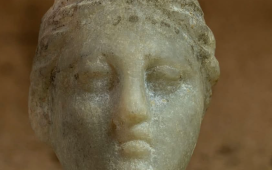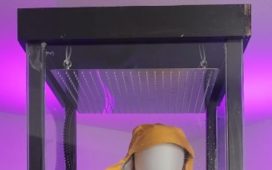[ad_1]
Bug with a taste for beans jumps into top ten list of the worst garden pests thanks to last year’s warm summer
- Southern green shield shot up to sixth place on Royal Horticural Society’s list
- RHS believe list has revealed the impacts of the hot dry weather last summer
- Sap feeder is thought to have been introduced from mainland Europe in 2000s
An invasive bug with a taste for beans has jumped into the top 10 list of the worst garden pests as it benefited from the warm summer.
The Royal Horticultural Society (RHS) said its latest annual list of which pests and diseases are causing the most trouble in gardens revealed the impacts of the hot dry weather last summer.
The southern green shield bug, which is thought to have been introduced from mainland Europe and was established here in the 2000s, came sixth in 2018’s ranking based on inquiries to the RHS by gardeners.
The bug is a sap feeder with some preference for vegetables, particularly beans, and benefited from the warm weather in early summer, the experts said.


The southern green shield bug, which is thought to have been introduced from mainland Europe and was established here in the 2000s, came sixth in 2018’s ranking of garden pests
Young stages of the bug are distinctively black with white or pink markings and an adult looks similar to the harmless native green shield bug but does not have a brown marking at its rear.
Pear rust is also of growing concern to gardeners, with the fungus that causes orange spots on pear leaves and canker-like swellings on juniper branches becoming very common over the last 16 years, in part due to warmer, drier summers.
But the dry conditions helped keep some problems at bay, including leaf spot and canker of Prunus and box blight, which both benefit from warm, wet weather during the growing season.
Overall, however, 2018 was another bad year for gardeners with box trees and hedges as box tree caterpillars spread to Wales and Northern Ireland.
The caterpillar, which strips box of its leaves, topped the list for the worst pests for the third time, the experts said.


The bug is a sap feeder with some preference for vegetables, particularly beans, and benefited from the warm weather in early summer, the experts said
Despite the dry conditions, perennial pests slugs and snails were in second place in the ranking of gardener inquiries, while honey fungus topped the list of diseases again in 2018.
Matthew Cromey, principal scientist at the RHS, said: ‘Our pest and disease ranking may be evidence of how climate change is impacting on what we find in our gardens.
‘With the UK predicted to see wetter winters, warmer summers and more extreme weather events, root diseases of trees and shrubs could become even more problematic and the array of pests is likely to change.
‘As the UK faces new plant health problems it’s imperative that the country has the skills needed to predict, exclude and manage the worst.’
The RHS said it is conducting research into several of the most prevalent pests and diseases including the range of slug and snail species in the UK, controls for box tree caterpillar and box blight and improved strategies for managing honey fungus.
[ad_2]
READ SOURCE













